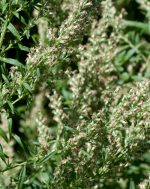 Also known as felon herb, mugwort is a rhizomatous herbaceous perennial and a member of the aster family, Asteraceae, that also includes daisies, yarrow, and lettuce. It is native to Europe, Asia and North Africa, and was introduced to North America in the early 1600 by settlers as an herbal plant . Since then it has naturalized in the US especially in the Northeast, Midwest, and a narrow band along the Pacific Coast. Preferring sites with lean, alkaline, dry to medium moist soils and full sun and mugwort grows well in disturbed sites such as roadsides, unmowed fields, and waste places.
Also known as felon herb, mugwort is a rhizomatous herbaceous perennial and a member of the aster family, Asteraceae, that also includes daisies, yarrow, and lettuce. It is native to Europe, Asia and North Africa, and was introduced to North America in the early 1600 by settlers as an herbal plant . Since then it has naturalized in the US especially in the Northeast, Midwest, and a narrow band along the Pacific Coast. Preferring sites with lean, alkaline, dry to medium moist soils and full sun and mugwort grows well in disturbed sites such as roadsides, unmowed fields, and waste places.
Description: Mugwort grows 2-4′ tall and spreads up to 6′ wide. Its upright reddish-brown stems carry narrow leaves up to four inches long. The leaves have deep finger-like lobes with green top sides and silver bottom sides covered with fuzzy white hairs. Leafy clusters of small yellow-green flowers appear from late summer into fall at the stem tips and leaf axils and give way to achenes.
Control: Plants spread by both seed and rhizomes and are difficult to eradicate because small pieces of rhizome can resprout if left in the soil. Pull or dig plants taking care to remove as much as the root system as possible. Hoe,mow, or cut shoots to the ground every week or two until sprouting ceases. Alternatively, spread a layer of dense mulch such as newspaper or cardboard over the entire area after cutting or mowing the plants. Under no circumstances let the plants go to seed. To discourage the return of mugwort add sulfur to the soil to make the soil more acid. In extreme cases, an herbicide such as dicamba, 2,4 D, or glyphosate can be used.